How Do Anchors Work?
The science of how anchors work relies on several factors including things like suction, pressure, weight and grip. This depends on the style of anchor and how it settles to the bottom. Let’s take a look at what’s going on when you drop your boat anchor and how such a relatively small tool can hold a much larger boat in place.
What Happens When an Anchor is Dropped?
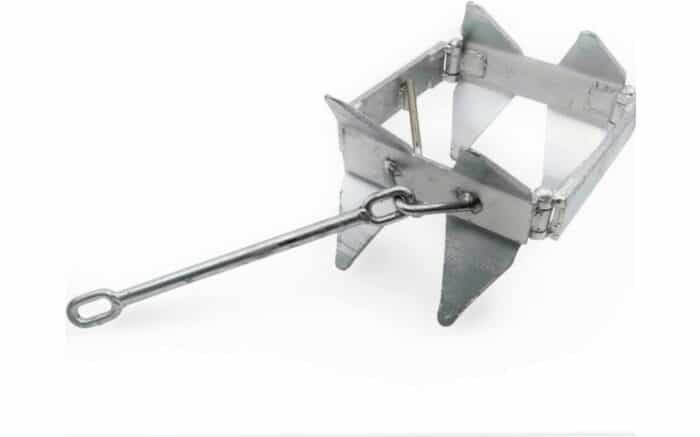
When you release the anchor and the line lets out, regardless of the anchor style, it will sink to the bottom and settle below your vessel. You need to have an idea of the depth of the water below your boat for this to work to ensure you have enough anchor rode to let out. Calculating the scope, which is the ratio of line to the depth of water, is important to enure your anchor works properly.
Understanding How Anchors Work
Anchors function by penetrating the seabed, utilizing their specially-designed flukes or hooks to dig in. When a boat tugs on the anchor’s chain, known as the rode, the anchor embeds itself deeper into the ocean floor. This action generates a resistance, comprised of both the seabed material and the overlying sediment weight, effectively securing the boat in place. The anchor’s holding capability is influenced by several factors, including its design, the seabed composition, and the pulling force exerted by the boat.
Setting
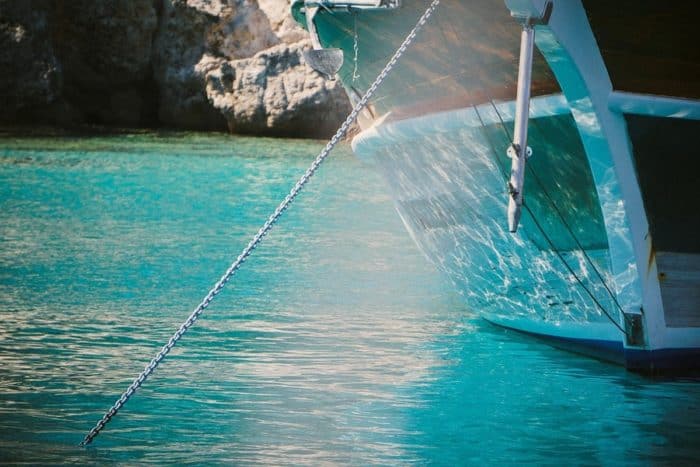
You “set” an anchor when you get it to take hold in the seabed the way you want it to. To set an anchor, some tension needs to be applied to the anchor line. In much the same way you need to set a hook after a fish bites, the anchor needs to be set by forcing it to really dig in and take hold. Otherwise your boat will drift with the anchor sitting uselessly on the bottom.
To set your anchor, you need to drop it and either let the wind/current move you back the length of your anchor line, or put the boat in reverse and very slowly move back that distance.
An anchor may need to be reset if it doesn’t set well, which can happen on rocks, or if the wind changes direction and pushes your boat in the opposite direction causing it to come loose.
Bottom Conditions
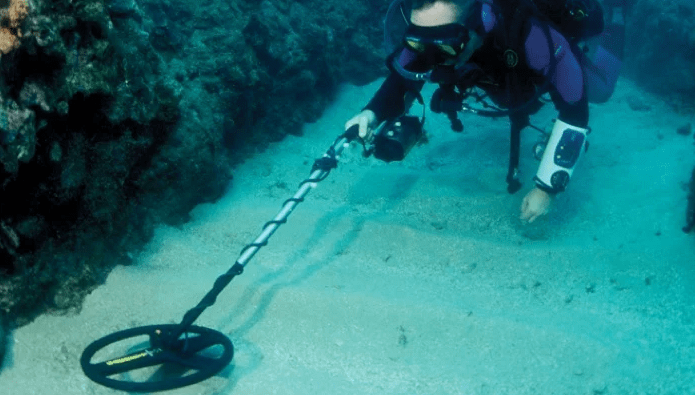
Bottom conditions affect both how an anchor holds and what kind of anchor you should use.
- Soft Bottoms: When you have mud or sand anchors can hold by using suction and pressure. Tension on the rode pulls an anchor and forces the flukes to dig in. This can create suction in mud and also pressure as the weight of the seabed and water forces the anchor down. Fluke-type anchors can hold well in soft bottoms.
- An anchor in mud has no force acting on it besides pressure until the anchor line is pulled, say by your boat drifting in current. The anchor pulls up and condenses the mud above it which pushes down on the anchor.
- The anchor creates a gap below it and the creation of that void produces suction pressure. It wants to balance that pressure by pulling the anchor back down to fill the hole. The bigger the anchor the more pressure is built and the greater the boat weight it will be able to hold in place.
- The anchor can work itself deeper and therefore increase the pressure as your boat tugs on the line. In some cases it can be difficult to retrieve it again when it gets a really good grip down there. The makeup of the seabed itself will greatly affect this. Thick mud can hold a lot better than loose sand or rocks.
- Additional anchors that work well in soft conditions include fortress anchors, claw anchor, plow anchor, and Bruce anchor.
- Hard Bottoms: If the seabed is made of rocks or hard clay, the anchor will need to dig in and get wedged in place. The hold is much more precarious in these cases. Shifting currents and movement of the anchor rode can more easily free an anchor in these cases.
- Something like a grapnel, which has three or four spikes or teeth on it, like a grappling hook l holds well in rocks.
Water Depth and Scope
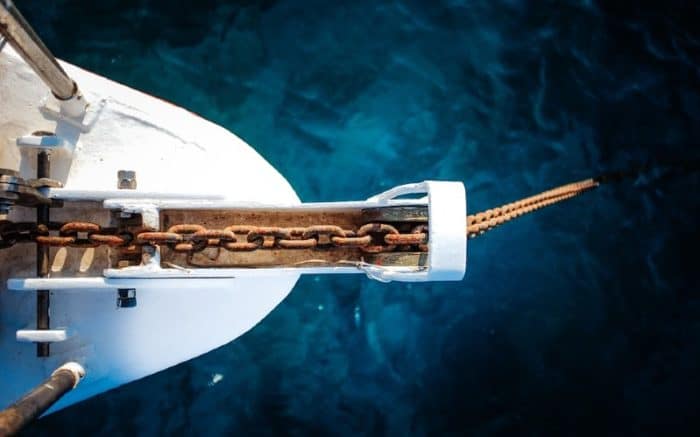
Knowing the depth of the water is important for two reasons: calculating scope and overall anchor effectiveness.
- Scope:The length of your anchor rope, or scope, should be at least 3 times the depth of the water. Seven times is a much more standard length to go by. That makes for a 3:1 ration or a 7:1 ratio.
- Some boaters will go as much as 10 times the depth. When you don’t let out enough line for your anchor you increase the tension on the line. If it’s extremely short it won’t set in the bottom at all, or it won’t set enough.
- If it does set on a short length, the motion of your boat can put too much strain on the anchor and it will be pulled free too easily. In other words, you won’t be able to anchor your boat at all. So the length of the anchor line can be as important as the type of anchor itself when it comes to how the anchor works.
- A long line allows the strain to be dispersed more evenly between the boat and the anchor. So when wind and current push the boat, the weight is distributed more evenly and it’s not all jerking on the anchor at once at the end of that short line, forcing it to pull free.
- Anchor Effectiveness: The weight of the water is partly responsible for keeping that anchor in place. Shallow water can make it harder to get an anchor to set.
- Without the added weight of deeper water, it can be harder to get an anchor to set into the bottom and really get a good grip to develop the suction you need to hold a boat in place. Anchors need the weight and pressure of the water to help them work at depth. The less water there is above the anchor, the less strong its overall grip is going to be.
- Shallow water anchors are meant to work fast and prevent a boat from drifting at all. Many of these are poles like the Power Pole that extend and stick into the bottom, holding the vessel in place with no rope needed. Because the water is shallow enough, it’s just like driving a stake into the ground that’s attached to your boat.
Boat Size vs Anchor Size
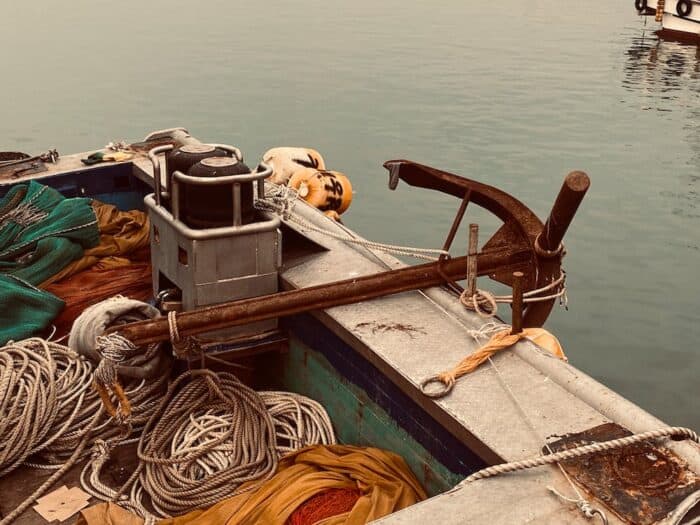
An anchor needs to be pulled on to both set and hold its place in the seabed. The weight of the boat adds more stress to the line and puts more pressure on the anchor itself as wind and current try to push it along. So the weight of the boat is transferred to the anchor which is what pulls it to create that suction pressure.
There’s some room to play with anchor weight and size to achieve the best results but a heavy anchor is not always the best choice. If your anchor is too heavy for your boat, the boat will have a harder time pulling and keeping pressure on the anchor so it won’t have as much force holding it in place as a result. So it’s possible a heavier anchor can do a worse job holding a boat than a lighter one.
Anchor Types
The type of anchor can affect how the anchor works in general. There are literally dozens of anchor types that a boater can choose from. You can read more about anchor types and how they work here.
Tight Anchorages
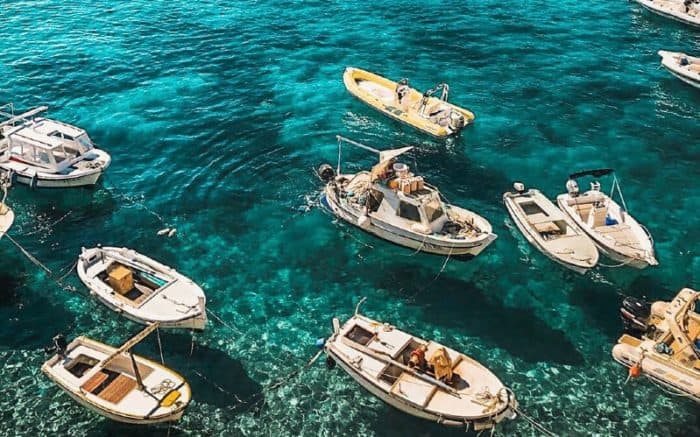
When you have limited space you may not be able to let out a long length of rode. If space is limited due to other boats or you’re in a lagoon, close to shore or in a narrow space for whatever reason, you may need to use two anchors to anchor your boat instead of one. This stops your boat from swinging around the anchor. You can deploy an anchor at the bow and stern or two off the bow with one 180 degrees from the other. The tension of one anchor rode can help set the second one. Under normal circumstances you don’t want to anchor at the stern.
The Bottom Line
Anchors work to hold boats chiefly by the pressure of the material on top of them and the suction caused below as force exerted by the boat pulls on them. A small anchor is therefore able to hold a much larger and heavier boat in place thanks to these forces.
The size, shape and style of an anchor changes how it holds depending on the bottom material that it digs into, as some anchors cannot hold a boat in some situations. This is why having at least two anchors onboard is a good idea, so you can adapt more easily.
The proper length of anchor rope and ensuring the anchor is properly set will help ensure the anchor stays in place and does its job.
Categories: Boats











